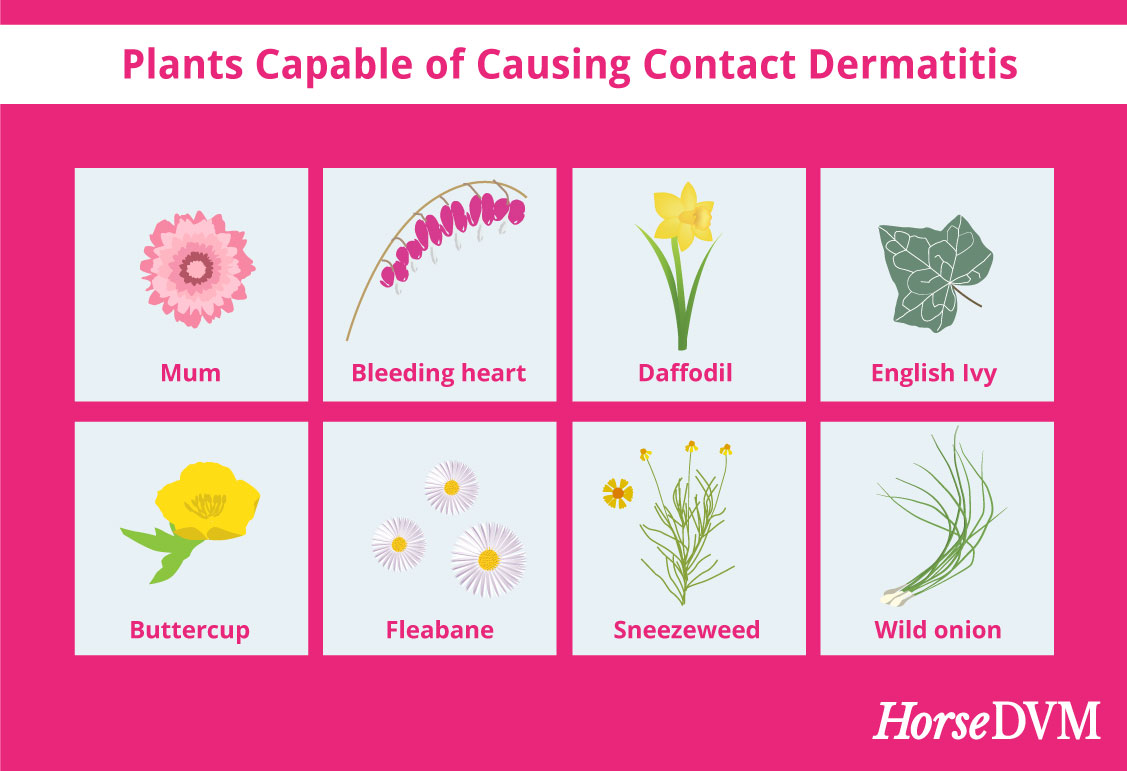Contact dermatitis is an inflammatory skin reaction resulting from direct-contact with an irritating agent and horse's skin. Moisture (humid weather, sweating, bathing, etc.) enhances the reaction. Pruritus (itching) might be mild to severe, sometimes painful. Primary lesions include the development of papules and vesicles, followed by a wide range of types of secondary lesions which occur as a result of the horse's reaction to the itching. There are many types of plants that are capable of causing contact dermatitis in horses, some of these include:
- Bleeding heart: Bleeding heart, also known as Dicentra spectabilis is a herbaceous perennial with distinctive dangling, pink w/ white heart-shaped flowers which resemble hearts. Although this plant doesn't normally grow in horse pastures, it can be placed around the vicinity of barns for ornamental purposes or sometimes in gardens. If horses gain access to these areas then they could could potentially develop contact dermatitis if they brush up against this plant.
- Daffodil: Daffodils (Narcissus spp.) are a popular spring-flowering bulb which blooms early spring. Daffodils develop attractive, yellow to cream-colored flowers that are usually single or in small groups, each having 6 petals with a trumpet-shaped corona in the middle of the flower. These flowers are seen quite often in horse pastures for whatever reason, and are also often planted near or in barns for ornamental purposes.
- Buttercup: Tall buttercup (Ranunculus acris) is a perennial that is often seen in horse pastures late spring, with a peak growth during the early summer months. It usually isn't a problem, however it can be if buttercup growth is the dominate species of plant in the pasture and horses can't help but be exposed.
- Sneezeweed: Sneezeweed (Helenium autumnale) is a tall, coarse, early smooth perennial herb from the daisy (Asteraceae) family. It produces numerous yellow flower blossoms during the late summer months. It is native to the United States and Mexico and is found in subtropical to warm temperate climates. It is commonly found in overgrown, weedy pastures and along fence lines during the mid to late summer months.

There are a wide range of causes of contact dermatitis---as it can be caused by anything from a particular clothing-like material (cotton, jute, chrome, hemp, etc.) used in blankets, fly sheets, leg wraps, towel, saddle pad, girth, or even something worn by the handler), grooming tool (particular brush), topical insecticides and shampoos, stall bedding, medication, and certain types of plants found in the pasture or within the stable yard or within reach of the horse (contact dermatitis-causing plants).
The location of the reaction can usually aid in the determination of its cause. A reaction in the girth region is likely related to the material the girth is made from. A reaction on the lower limbs of the horse would most likely be the cause of contact-dermatitis causing plants or a reaction to leg wrap material.